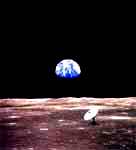International Lunar Observatory Overview

Earthrise Over ILO |
Numerous international lunar observatory proposals have been made during the fledgling history of the Space Age. The International Lunar Observatory (ILO) is different; Space Age Publishing Company (SPC) has stepped forward to initiate the mission, envisioned as an initial step in humankind’s lunar base build-out (near the Lunar South Pole). The ILO pushes the limits of observation, providing the best investment ever made in an astrophysics instrument. The ILO will test and prove the concept of conducting robotic astronomy from the Moon just as NASA is mobilizing to return humans to its surface and other nations are working to send and operate an international fleet of lunar science spacecraft. It is common knowledge in the scientific and space community that, in order to save humanity from an inevitable cataclysmic event, a better understanding of the universe and steps toward becoming a multi-planet species (each starting with the Moon) must be achieved.
In mid-2003, SPC’s subsidiary, Lunar Enterprise Corporation (LEC), commissioned SpaceDev, Inc., a Poway , California-based, low-cost space industry solutions company, to conduct a Phase-A study for an ILO concept. SPC wanted to see if an ideal lunar-based astronomy mission could be accomplished within a short period of time, with today’s technology and for low-cost. SpaceDev’s Phase-A study, finished in late-2003 and presented at the International Lunar Conference (ILC) 2003 / International Lunar Exploration Working Group (ILEWG) 5 / International Conference on Exploration and Utilization of the Moon (ICEUM) 5 in Waikoloa, Hawaii Island, USA (which SPC organized) concluded that such a mission was indeed feasible – and for remarkably low-cost.
According to the Phase-A study, it could take less than two years to develop the ILO and place it on the lunar surface. The mission utilizes what’s been learned from many previous Moon missions. In helping to create the ILO, SpaceDev can utilize its experience from developing and operating the revolutionarily low-cost CHIPSAT mission for NASA. The ILO can be constructed using the lowest cost, highest quality parts and materials that the space industry has to offer. It can be ground tested in and operated from the most affordable facilities. SpaceDev’s Phase-A study suggests the dependable, low-cost Ukraine Dnepr rocket as the ILO’s launch vehicle. After blasting off from Baikonur Cosmodrome or Russia ’s Dombarovsky base, the ILO mission is flexible. It could reach the Moon in less than a week or else take one to two months to reach the Moon, inspecting the landing site and taking valuable Earthrise imagery. This would actually lower the overall mission cost by reducing the number of necessary ground stations.
Based on the Phase-A study’s suggestion to learn more about landing aspects of the mission, a Phase-B study, which LEC commissioned from SpaceDev in July 2004, focused on landing capabilities to ensure that the ILO arrives at the Lunar South Pole safely and precisely. This second study was completed in November 2004 and presented by SpaceDev CEO Jim Benson at the ILC2004 / ILEWG 6 / ICEUM 6 in Udaipur, India.
The Phase-B study opted against the added expense of an orbiter to aid the ILO’s navigation, instead providing the option of using several reliable methods that employ the lunar surface. The study concludes that using one or any combination of these methods would allow the ILO to land within about 100 meters of a specific target location – accuracy that has never before been achieved. SPC and SpaceDev also obtained display models of the ILO, which can be seen in Poway, CA or Kamuela, HI.
As currently envisioned by SPC, the ILO will be an approximately two-meter dish, multi-wavelength observatory standing at about three meters in height, with communications and solar power gathering capabilities. Several missions and payloads can be added to the ILO to increase the scope of its overall mission. An arm with a water ice ground truth detection capability or a lunar rover are among these possibilities.